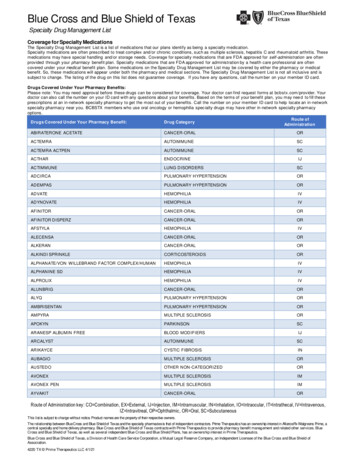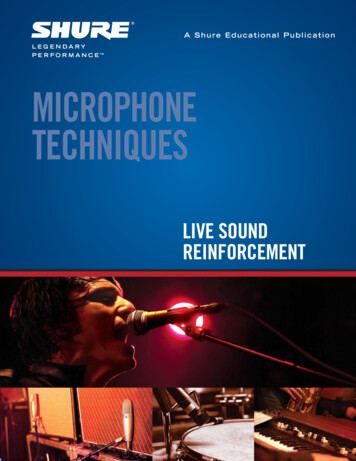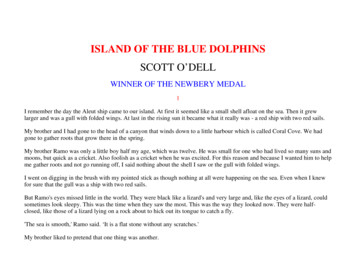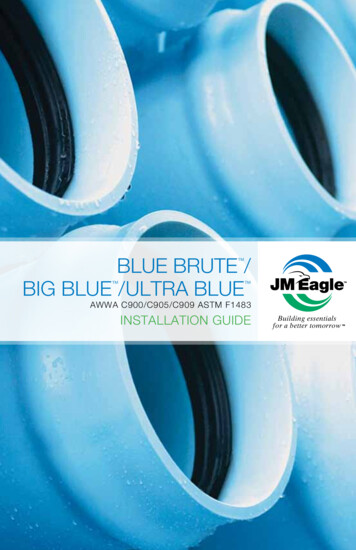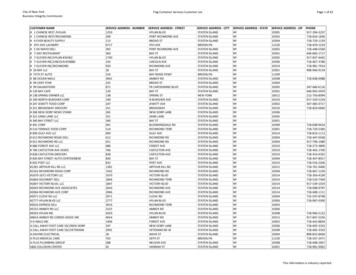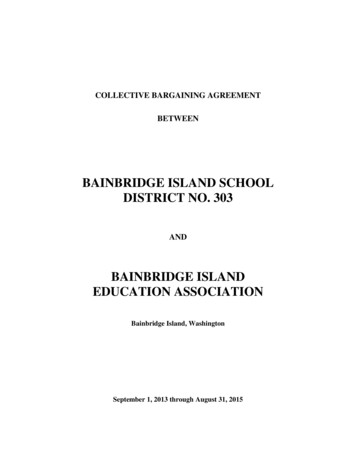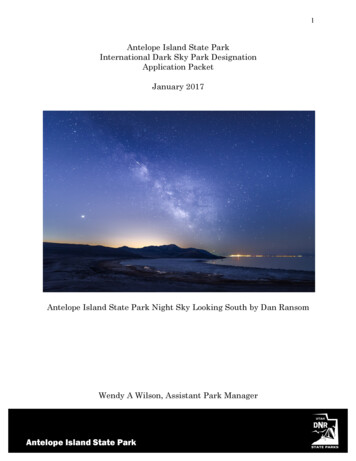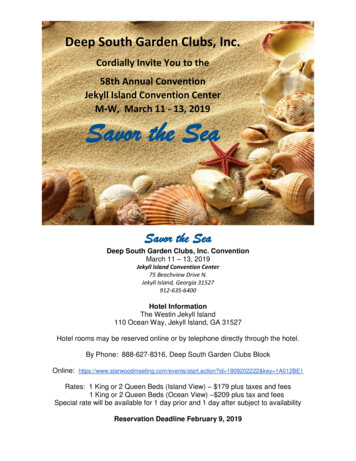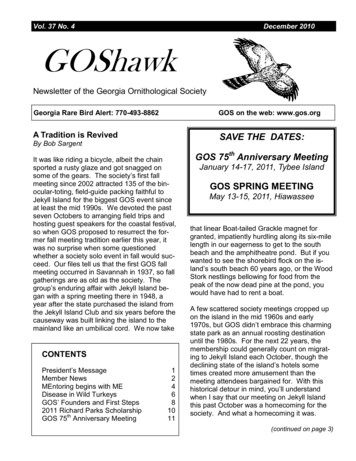
Transcription
Long Island Sound Blue Plan – Potential Data Products ReviewMarine mammals and sea turtlesMap Book Table of Contents1. NOAA ESI (Environmental Sensitivity Index) Marine Mammalsa. Harbor sealb. Gray sealc. Harbor porpoised. Bottlenose dolphine. North Atlantic right whale2. NOAA ESI Marine Mammals Habitat3. Sea Turtles – number of sightings above average (TNC Northwest Atlantic MarineEcoregional Assessment)4. Green sea turtle spring SPUE (TNC NAMERA)5. Green sea turtle summer SPUE (TNC NAMERA)6. Green sea turtle fall SPUE (TNC NAMERA)7. Green sea turtle winter SPUE (TNC NAMERA)8. Leatherback sea turtle spring SPUE (TNC NAMERA)9. Leatherback sea turtle summer SPUE (TNC NAMERA)10. Leatherback sea turtle fall SPUE (TNC NAMERA)11. Leatherback sea turtle winter SPUE (TNC NAMERA)12. Loggerhead sea turtle spring SPUE (TNC NAMERA)13. Loggerhead sea turtle summer SPUE (TNC NAMERA)14. Loggerhead sea turtle fall SPUE (TNC NAMERA)15. Loggerhead sea turtle winter SPUE (TNC NAMERA)2
NOAA ESI Marine MammalsData not currently available onlineSource: NOAA Office of Response and Restoration3
NOAA ESI Marine MammalsBlue Plan Sector(s): Living Resources Animals Marine Mammals & Sea TurtlesSummary Description: Marine mammals depicted in this atlas include seals, dolphins and whales. The most common seal foundin the atlas area is the harbor seal. Harbor seals have established several regular haul out sites in Long Island. Harbor sealsgenerally start showing up in Long Island Sound around late August in small numbers and then in larger numbers later in the falland will stay through the winter months and into March. By April most will have left the area but a few will still be present. Theharbor seal population is noted to have been steadily increasing in recent years. In Long Island Sound, harbor seals typically haulout on the sheltered parts of offshore rocky ledges and boulders during low tide. Gray seals are also common but not nearly asabundant as the harbor seal, except on Little Gull Island where they have established a year round haul out. Gray seals may beexpected to be sighted in low numbers wherever harbor seals haul out and may be present year round. Other seal species thatmay occasionally show up in Long Island but not mapped here are harp and hooded seals. When they are sighted, it is usuallyamong the many harbor seals at seal haul out sites. Small numbers of bottlenose dolphin sightings are possible throughout LongIsland Sound from May through September. Large pods of dolphins (75 – 150 individuals) enter the sound on occasion, most likelyattracted by large schools of bait fish. These larger occurrences are unpredictable and usually occur many years apart (2015 and2009 most recently). Although harbor porpoises are known to frequent the waters of Long Island Sound, there are no existingsurveys and very little is known about their actual numbers or distribution. The common dolphin, saddle-backed dolphin andAtlantic white sided dolphin are not considered common in Long Island Sound, although they may be occasionally sighted. Theonly regular sightings of whales occur in the far eastern part of Long Island Sound, where humpback and right whales are knownto occur with some frequency. For the most part whale occurrences are uncommon and unpredictable in rest of the sound.Humpback, beluga, minke, long finned pilot and finback whales all have been occasionally spotted, separated by many years at atime, and there is no predictability for when they might enter the sound.Though the data will be useful for many shoreline applications, the goal of the ESI data is to present a concise summary ofresources that may be particularly vulnerable to spilled oil. The intent of the data should caveat other uses. As an example, theESI is not intended to present a catalog or comprehensive listing of species present in an area, rather the focus is on speciesparticularly sensitive to oiling and life stages where vulnerability may increase.Full Description: not available as individual file; can be accessed as part of larger data download located ConnecticutAccess Instructions: data not currently available via online viewer; can be accessed as part of larger data download located Connecticut4
NOAA ESI Marine MammalsBiofile data example: ESI uses a relational database structure to link many species recordsto a single area. The multiple records below correspond to the single selected area in thezoomed in map sample.5
Marine Mammals HabitatNortheast Ocean Data (NEODP)Source: NOAA Environmental Sensitivity Index (ESI)6
Marine Mammals HabitatBlue Plan Sector(s): Ecological Characterization Living Resources Animals MarineMammals & Sea TurtlesSummary Description: This map layer shows sensitive habitat for marine mammal speciesin Connecticut, Massachusetts, New Hampshire, New York and Rhode Island. Multiplerecords may be available at the same feature location. The data were created fromNOAA's Environmental Sensitivity Index, which was developed to characterize shorelinesbased on their sensitivity to spilled oil in order to understand the potential risk to thesespecies.Full eMammalsHabitat.pdfAccess Instructions: Go to: http://www.northeastoceandata.org/data-explorer/In the layers box, expand Marine Mammals and Sea Turtles Marine Mammals andselect the layer “Marine Mammals Habitat”7
Sea TurtlesMid-Atlantic Ocean Data PortalSource: NOAA, The Nature Conservancy: NorthwestAtlantic Marine Ecoregional Assessment8
Sea TurtlesBlue Plan Sector(s): Ecological Characterization Living Resources Animals MarineMammals & Sea TurtlesSummary Description: Areas where sightings of loggerhead, leatherback, or green seaturtles are common. Areas where sightings per unit effort for loggerhead, leatherback andgreen sea turtles were two or more standard deviations higher than the regional average.For these species, 'regional' includes the Mid-Atlantic, Southern New England and the Gulfof Maine.Full tic/data s Instructions: Go to:http://portal.midatlanticocean.org/visualize/#x -72.13&y 41.23&z 10&logo true&controls true&dls%5B%5D true&dls%5B%5D 0.5&dls%5B%5D 60&dls%5B%5D false&dls%5B%5D 0.5&dls%5B%5D 484&basemap Ocean&themes%5Bids%5D%5B%5D 2&tab data&legends false&layers trueAnd search “Sea Turtles” under the Data tab9
Green Sea Turtle Spring, SPUENortheast Ocean Data (NEODP)Source: The Nature Conservancy 2010, U.S. Navy10
Green Sea Turtle Spring, SPUEBlue Plan Sector(s): Ecological Characterization Living Resources Animals MarineMammals & Sea TurtlesSummary Description: This map layer shows sightings per unit effort (SPUE) for green seaturtles from the Gulf of Maine to Cape Hatteras, North Carolina, during spring. The datacover the period from 1979 to 2007 and are shown on the map in ten-minute squares. TheNature Conservancy generated this map layer using a geospatial dataset compiled by theU.S. Navy, including sightings data from NMFS-NEFSC Aerial Surveys, NMFS-NEFSCShipboard Surveys, and the North Atlantic Right Whale Consortium Database. Navycontractors screened and verified the validity of sightings.Full rtleSPUEspring.pdfAccess Instructions: Go to: http://www.northeastoceandata.org/data-explorer/In the layers box, expand Marine Mammals & Sea Turtles Sea Turtles and select the layer“Green Sea Turtle Spring, SPUE”11
Green Sea Turtle Summer, SPUENortheast Ocean Data (NEODP)Source: The Nature Conservancy 2010, U.S. Navy12
Green Sea Turtle Summer, SPUEBlue Plan Sector(s): Ecological Characterization Living Resources Animals MarineMammals & Sea TurtlesSummary Description: This map layer shows sightings per unit effort (SPUE) for green seaturtles from the Gulf of Maine to Cape Hatteras, North Carolina, during summer. The datacover the period from 1979 to 2007 and are shown on the map in ten-minute squares. TheNature Conservancy generated this map layer using a geospatial dataset compiled by theU.S. Navy, including sightings data from NMFS-NEFSC Aerial Surveys, NMFS-NEFSCShipboard Surveys, and the North Atlantic Right Whale Consortium Database. Navycontractors screened and verified the validity of sightings.Full rtleSPUEsummer.pdfAccess Instructions: Go to: http://www.northeastoceandata.org/data-explorer/In the layers box, expand Marine Mammals & Sea Turtles Sea Turtles and select the layer“Green Sea Turtle Summer, SPUE”13
Green Sea Turtle Fall, SPUENortheast Ocean Data (NEODP)Source: The Nature Conservancy 2010, U.S. Navy14
Green Sea Turtle Fall, SPUEBlue Plan Sector(s): Ecological Characterization Living Resources Animals MarineMammals & Sea TurtlesSummary Description: This map layer shows sightings per unit effort (SPUE) for green seaturtles from the Gulf of Maine to Cape Hatteras, North Carolina, during fall. The data coverthe period from 1979 to 2007 and are shown on the map in ten-minute squares. TheNature Conservancy generated this map layer using a geospatial dataset compiled by theU.S. Navy, including sightings data from NMFS-NEFSC Aerial Surveys, NMFS-NEFSCShipboard Surveys, and the North Atlantic Right Whale Consortium Database. Navycontractors screened and verified the validity of sightings.Full rtleSPUEfall.pdfAccess Instructions: Go to: http://www.northeastoceandata.org/data-explorer/In the layers box, expand Marine Mammals & Sea Turtles Sea Turtles and select the layer“Green Sea Turtle Fall, SPUE”15
16
17
Leatherback Sea Turtle Spring, SPUENortheast Ocean Data (NEODP)Source: The Nature Conservancy 2010, U.S. Navy18
Leatherback Sea Turtle Spring, SPUEBlue Plan Sector(s): Ecological Characterization Living Resources Animals MarineMammals & Sea TurtlesSummary Description: This map layer shows sightings per unit effort (SPUE) forleatherback sea turtles from the Gulf of Maine to Cape Hatteras, North Carolina, duringspring. The data cover the period from 1979 to 2007 and are shown on the map inten-minute squares. The Nature Conservancy generated this map layer using a geospatialdataset compiled by the U.S. Navy, including sightings data from NMFS-NEFSC AerialSurveys, NMFS-NEFSC Shipboard Surveys, and the North Atlantic Right Whale ConsortiumDatabase. Navy contractors screened and verified the validity of sightings.Full rtleSPUEspring.pdfAccess Instructions: Go to: http://www.northeastoceandata.org/data-explorer/In the layers box, expand Marine Mammals & Sea Turtles Sea Turtles and select the layer“Leatherback Sea Turtle Spring, SPUE”19
Leatherback Sea Turtle Summer, SPUENortheast Ocean Data (NEODP)Source: The Nature Conservancy 2010, U.S. Navy20
Leatherback Sea Turtle Summer, SPUEBlue Plan Sector(s): Ecological Characterization Living Resources Animals MarineMammals & Sea TurtlesSummary Description: This map layer shows sightings per unit effort (SPUE) forleatherback sea turtles from the Gulf of Maine to Cape Hatteras, North Carolina, duringsummer. The data cover the period from 1979 to 2007 and are shown on the map inten-minute squares. The Nature Conservancy generated this map layer using a geospatialdataset compiled by the U.S. Navy, including sightings data from NMFS-NEFSC AerialSurveys, NMFS-NEFSC Shipboard Surveys, and the North Atlantic Right Whale ConsortiumDatabase. Navy contractors screened and verified the validity of sightings.Full rtleSPUEsummer.pdfAccess Instructions: Go to: http://www.northeastoceandata.org/data-explorer/In the layers box, expand Marine Mammals & Sea Turtles Sea Turtles and select the layer“Leatherback Sea Turtle Summer, SPUE”21
22
23
Leatherback Sea Turtle Winter, SPUENortheast Ocean Data (NEODP)Source: The Nature Conservancy 2010, U.S. Navy24
Leatherback Sea Turtle Winter, SPUEBlue Plan Sector(s): Ecological Characterization Living Resources Animals MarineMammals & Sea TurtlesSummary Description: This map layer shows sightings per unit effort (SPUE) forleatherback sea turtles from the Gulf of Maine to Cape Hatteras, North Carolina, duringwinter. The data cover the period from 1979 to 2007 and are shown on the map inten-minute squares. The Nature Conservancy generated this map layer using a geospatialdataset compiled by the U.S. Navy, including sightings data from NMFS-NEFSC AerialSurveys, NMFS-NEFSC Shipboard Surveys, and the North Atlantic Right Whale ConsortiumDatabase. Navy contractors screened and verified the validity of sightings.Full rtleSPUEwinter.pdfAccess Instructions: Go to: http://www.northeastoceandata.org/data-explorer/In the layers box, expand Marine Mammals & Sea Turtles Sea Turtles and select the layer“Leatherback Sea Turtle Winter, SPUE”25
26
27
Loggerhead Sea Turtle Summer, SPUENortheast Ocean Data (NEODP)Source: The Nature Conservancy 2010, U.S. Navy28
Loggerhead Sea Turtle Winter,Summer,SPUESPUEBlue Plan Sector(s): Ecological Characterization Living Resources Animals MarineMammals & Sea TurtlesSummary Description: This map layer shows sightings per unit effort (SPUE) forloggerhead sea turtles from the Gulf of Maine to Cape Hatteras, North Carolina, duringsummer. The data cover the period from 1979 to 2007 and are shown on the map inten-minute squares. The Nature Conservancy generated this map layer using a geospatialdataset compiled by the U.S. Navy, including sightings data from NMFS-NEFSC AerialSurveys, NMFS-NEFSC Shipboard Surveys, and the North Atlantic Right Whale ConsortiumDatabase. Navy contractors screened and verified the validity of sightings.Full rtleSPUEsummer.pdfAccess Instructions: Go to: http://www.northeastoceandata.org/data-explorer/In the layers box, expand Marine Mammals & Sea Turtles Sea Turtles and select the layer“Loggerhead Sea Turtle Summer, SPUE”29
Loggerhead Sea Turtle Fall, SPUENortheast Ocean Data (NEODP)Source: The Nature Conservancy 2010, U.S. Navy30
Loggerhead Sea Turtle Fall, SPUEBlue Plan Sector(s): Ecological Characterization Living Resources Animals MarineMammals & Sea TurtlesSummary Description: This map layer shows sightings per unit effort (SPUE) forloggerhead sea turtles from the Gulf of Maine to Cape Hatteras, North Carolina, duringfall. The data cover the period from 1979 to 2007 and are shown on the map in ten-minutesquares. The Nature Conservancy generated this map layer using a geospatial datasetcompiled by the U.S. Navy, including sightings data from NMFS-NEFSC Aerial Surveys,NMFS-NEFSC Shipboard Surveys, and the North Atlantic Right Whale ConsortiumDatabase. Navy contractors screened and verified the validity of sightings.Full rtleSPUEfall.pdfAccess Instructions: Go to: http://www.northeastoceandata.org/data-explorer/In the layers box, expand Marine Mammals & Sea Turtles Sea Turtles and select the layer“Loggerhead Sea Turtle Fall, SPUE”31
Loggerhead Sea Turtle Winter, SPUENortheast Ocean Data (NEODP)Source: The Nature Conservancy 2010, U.S. Navy32
Loggerhead Sea Turtle Winter, SPUEBlue Plan Sector(s): Ecological Characterization Living Resources Animals MarineMammals & Sea TurtlesSummary Description: This map layer shows sightings per unit effort (SPUE) forloggerhead sea turtles from the Gulf of Maine to Cape Hatteras, North Carolina, duringwinter. The data cover the period from 1979 to 2007 and are shown on the map inten-minute squares. The Nature Conservancy generated this map layer using a geospatialdataset compiled by the U.S. Navy, including sightings data from NMFS-NEFSC AerialSurveys, NMFS-NEFSC Shipboard Surveys, and the North Atlantic Right Whale ConsortiumDatabase. Navy contractors screened and verified the validity of sightings.Full rtleSPUEwinter.pdfAccess Instructions: Go to: http://www.northeastoceandata.org/data-explorer/In the layers box, expand Marine Mammals & Sea Turtles Sea Turtles and select the layer“Loggerhead Sea Turtle Winter, SPUE”33
Blue Plan Sector(s): Living Resources Animals Marine Mammals & Sea Turtles Summary Description: Marine mammals depicted in this atlas include seals, dolphins and whales. The most common seal found in the atlas area is the harbor seal. Harbor seals have established several regular hau
